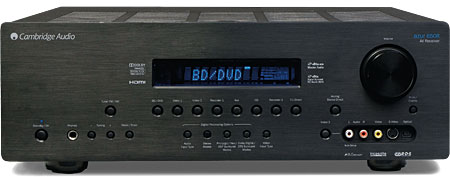Cambridge Audio Azur 650R A/V Receiver Page 2
 Don’t look for fancy video processing, either. The Azur 650R cross-converts all video sources to HDMI, but it doesn’t perform upconversion of any incoming source. The HDMI inputs are passthrough only for video. Cambridge expects your display device or external video processor to do the heavy lifting. I personally think that’s a good thing, but you might run into issues with 480i sources, including the Azur 650R’s lackluster menus, which it generates in 480i. Support for 480i over HDMI is optional in the HDMI specs, and a few companies’ displays don’t support it. If you happen to have a fine Samsung plasma HDTV (as I do) or another display that doesn’t accept 480i over HDMI, you won’t be able to see the AVR’s menus—or watch other 480i sources through the AVR—unless you use an analog video connection from the AVR to the HDTV in addition to the HDMI connection. And then you’ll have to switch inputs on the HDTV depending on what you’re watching.
Don’t look for fancy video processing, either. The Azur 650R cross-converts all video sources to HDMI, but it doesn’t perform upconversion of any incoming source. The HDMI inputs are passthrough only for video. Cambridge expects your display device or external video processor to do the heavy lifting. I personally think that’s a good thing, but you might run into issues with 480i sources, including the Azur 650R’s lackluster menus, which it generates in 480i. Support for 480i over HDMI is optional in the HDMI specs, and a few companies’ displays don’t support it. If you happen to have a fine Samsung plasma HDTV (as I do) or another display that doesn’t accept 480i over HDMI, you won’t be able to see the AVR’s menus—or watch other 480i sources through the AVR—unless you use an analog video connection from the AVR to the HDTV in addition to the HDMI connection. And then you’ll have to switch inputs on the HDTV depending on what you’re watching.
Additionally, the HDMI here is 1.3, which means this AVR isn’t outfitted to switch 3D high-def video. If you want to add 3D at some point, you’ll need to get a Blu-ray 3D player with dual HDMI outputs so you can run the audio directly into the Cambridge and the video directly to a 3D display.
Domus Multiroomus Simplicitus
The Azur 650R includes outputs for two Incognito (Cambridge Audio’s proprietary A-BUS upgrade system) or other A-BUS-compatible keypads. You can use these to make the AVR a multiroom master. As I mentioned earlier, A-BUS technology is designed for simple audiosource-only distribution. I’ve worked with other A-BUS systems in the past, and the Cambridge Audio gear works in much the same way—A-BUS is a standard that should be compatible across brands. The beauty of A-BUS is three-fold. One, the amplified keypads connect to the AVR with single runs of Cat-5 cable (simple wiring makes it easy to install in both new and retro installations). Two, since the keypads include their own amplification, you don’t need any additional components (other than the keypads and speakers). Three, the AVR doesn’t use any of its amplification to power speakers in the remote rooms, so there’s no drain on the power supply or need to drop down to 5.1 from 7.1 channels (or biamplified 5.1) in the main theater. Technically, the Azur 650R is a two-zone, three-room AVR. Although the keypads can play a source that’s the same or different from the source playing in the main room, each keypad must play the same source as the other. On the other hand, volume on the keypads is totally independent. A true three-zone AVR would give each keypad access to all sources regardless of the status of the other keypad. However, unlike many multiroom AVRs (especially ones that use A-BUS architecture), the Azur 650R provides a bonus. It has composite video outputs for zones two and three. That means you can use the system for multiroom video as well as audio. But since A-BUS doesn’t pass video down the Cat-5 cable, the video needs a separate composite video cable run. This makes the installation a little more involved. The AVR downconverts all inputs except HDMI to composite video, so you’ll only need a second video connection to the AVR for HDMI sources.

As I expected, Cambridge Audio’s Incognito keypad couldn’t have been simpler to install and use. At first, I ran into a glitch when the keypad wouldn’t power up. I briefly unplugged the AVR from the AC outlet, and that quickly solved the problem. The keypad powered up, played flawlessly, and sounded great. Incognito keypads are standard, single-gang size with six small LEDs across the top of the pad and a large circular control pad in the center. The control pad seems to work much better than the one on the remote control. When you press the pad up or down, it changes the volume in that particular room. The left and right sides of the pad let you switch among the Azur 650R’s various inputs. A built-in IR receiver passes IR signals back down the Cat-5 cable to three mini-jack outputs on the back of the AVR that you can connect to individual IR emitters placed in front of source components. All Is Forgiven
So much for the guts and the bits I didn’t like. I listened to the Azur 650R through three different sets of speakers over the course of several weeks, and it made me a believer in the AVR again. Think of all the superlative adjectives you would normally use with a fantastically engineered (from a sonic standpoint) piece of audio gear: natural, open, sweet, stunning, awesome, astounding, ear-fondling, and “connects your brain directly to the music.” Really, none of those terms is quite good enough. The best way I can describe it is this: Usually, a reviewer spends a lot of time actively listening to a product, trying to pick the sound apart and find any flaws. This often gets in the way of really enjoying the music or movie for its own sake. But the Azur 650R is so open and revealing that it just disappears. You quickly forget that you were supposed to be evaluating the sound quality. I can’t think of another AVR I’ve heard that’s quite so transparent.

Power isn’t an issue, either. For a while, I ran the Azur 650R through my Legacy in-walls. I set the speakers as full-range and didn’t use a subwoofer, so the AVR had to do all the hard work driving the big woofers in those massive in-walls. The Legacy speaker’s nominal impedance is under 4 ohms, so it wasn’t a picnic for the Azur 650R from that standpoint, either. Regardless of what I threw at it, from SMV, Lady Gaga, and Stevie Ray Vaughn to more laid-back pieces from Tronheim Solistene and Getz /Gilberto, the Azur 650R never flinched. If there’s ever a hall of fame for AVR sound quality, the Azur 650R will definitely be in it.
Royal AVR
Even though I’ve hit these guys hard over some mostly minor issues—poor menus and a lousy remote control, for the most part—the Cambridge Audio Azur 650R is one of the finest-sounding AVRs I’ve ever heard. It won’t satisfy everyone, especially people who like pretty menus and more automated setup routines. But if you’re hunting for the perfect AVR from a sound-quality-only standpoint that’s under $2,000, you’ll have a hard time finding something better than the Azur 650R. This thing’s a beauty when it comes to sheer audio performance, and the multiroom flexibility and added biamping for the front speakers should make it a favorite of higher-end installers. If you’re not a fan of bells and whistles and you want to spend your money on audio performance rather than flash, this is your AVR. The British may not have their empire anymore, but the Azur 650R definitely rules.






























































